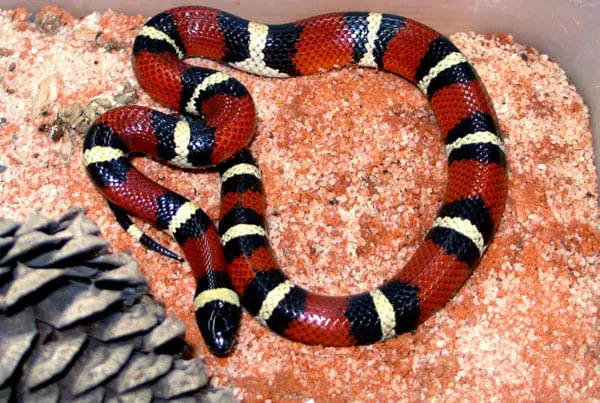Scientific Facts
| Common Name: | Mexican Milk Snake |
| Scientific Name: | Lampropeltis annulata |
| Life Span: | 12 to 20 years |
| Caring Skill Requirement: | Beginner |
| Length: | 24 to 30 inches, on average |
| Habitat: | Grasslands, fields, and dry prairie habitats |
| Country of Origin: | Mexico and Texas, United States |
Physical Description
Milk snakes are known for their black, red, and yellow colored banding, and the Mexican milk snake is no different. Sometimes, this is seen by experts as a self-defense mechanism that is mimicking the image of venomous coral snakes. Mexican milk snakes located toward the west, have lighter creams instead of yellows, while those who are located in the north and the east have dirtier cream looks. On the other hand, those in the south have yellow, dark yellow, or orange bandings.
On the underside of these snakes, you will be able to see some checkered blacks and whites. Southern locals will have higher black colors, while northern locals will have more whites.
In comparison to other milk snake breeds, the Mexican ones have darker light bands as the first, followed by a black one, then a mix of cream yellow, orange-yellow, or yellow for the last band. The light bands also tend to be more pronounced compared to the darker bands, and their red bands are even more crisp and dark compared to other milk snakes.
When looking at the length, the Mexican milk snakes are fairly large and long at 24 to 30 inches, combined with a thicker girth. Their hatchlings are only about 4 to 8 inches. Like other snake species, the female ones grow much bigger than the males.
Conservation Status
Last assessed on April 6, 2016, the Mexican milk snake’s species conservation is of least concern against extinction. This is according to IUCN’s Red List.
Life Span
Mexican milk snakes live up to 20 years, especially if kept under ideal growing conditions.
Availability and Natural Habitat
The Mexican milk snakes are available in Nuevo Leon, Tamaulipas, and Coahuila regions of northeastern Mexico. It can also be found in the United States, most likely, towards Southwestern Texas.
Behavior
Mexican milk snakes are more active at night, and they are labeled as crepuscular and nocturnal. When temperatures are hotter, these snakes prefer to hide, and they only choose to be active during the generally colder periods.
Diet
Like other snakes, Mexican milk snakes are carnivorous creatures. While they are in the wild, these milk snakes usually eat lizards and rodents and occasionally eat frogs and other breeds of snakes. Though they are not totally immune to the venom of other snakes, they are highly resistant to their effects.
Eating Habits
When the Mexican milk snakes are in captivity, their typical prey item would be mice, whether frozen then thawed or live mice. However, though the adults are easy to feed with mice, some hatchlings might need to be introduced with lizards first, just to introduce meals to their appetite.
Whenever you offer new food materials to your mice, make sure that their meal is just slightly larger than the widest part of your snake’s body. Usually, a prey item larger than 1.5 times will be enough to form a little lump on the milk snake’s body.
Young hatchling milk snakes must be fed once every 5 to 7 days. Juvenile Mexican milk snakes must be fed every 7 to 10 days. Lastly, matured Mexican milk snakes must be fed every 10 to 14 days, depending on how well they can maintain their body’s weight.
Handling
Compared to other famous snakes recommended for beginner keepers, Mexican milk snakes are slightly more skittish. However, there is no need to be worried; they are still very much easy to handle, docile, and gains confidence as they are growing older. Also, unlike other milk snakes, they very rarely bite when they feel threatened, and they don’t give off their musky defense either.
When you are holding your pet Mexican milk snake, always give your attention to them, as they are very active. The moment that you first get your milk snake, you should allow it an adjustment period to fully adapt to its new environment before you shock it by handling the snake. Wait until the snake has already defecated and has done eating before you attempt handling for the first time. For the succeeding handling sessions, make sure that after the snakes have eaten, you will only handle them after 48 hours have passed.
Common Health Problems
Here are the simplest problems encountered by Mexican milk snakes.
Snake not eating
Usually, Mexican milk snakes are very enthusiastic eaters. If they are just new to moving into your home, it might take them a few weeks before they feel comfortable enough to eat. If you see them losing a significant amount of weight, yet they still do not like eating, take them to the veterinarian.
Shedding problems
To help your snake cope up with shedding issues, make sure that they have plenty of textures to rub against and that there is a proper humidity throughout the enclosure. You should also make a humid hide box and a large water bowl inside. If the problem is intense, give them a warm bath and help them remove the extra skin.
Caging
For their housing, Mexican milk snakes must be ideally as long as their enclosure. Since these snakes are around 28 to 30 inches long, an ideal length of the cage must be 3 foot long or a 40-gallon tank. However, if there are larger Mexican milk snakes, their enclosures must be larger so that they can extend and fully stretch their bodies. These milk snakes are active, so they would rather explore and roam around their enclosure.
Instead of a vivarium that is open at the top, experts suggest using a cage that opens at the front. Like all other milk snakes, you should ensure that the enclosure is escape-proof, to prevent possible problems. Also, Mexican milk snakes can eat other snakes, so they must be housed individually if you would choose to keep more.
Additionally, you should provide your snake with two hide boxes located on the opposite ends of the terrarium. Also, you can decorate the enclosure with vines, tubes, branches, and plants. This will encourage your snake to climb, and it will be an extra layer of security to the terrarium. This bioactive ecosystem adds another layer of hominess to your pet snake’s enclosure.
Substrate
The most common substrates that you should use are kiln-dried pine or aspen shavings. If you would prefer a natural option, mixing organic soil and play sand can be a great option, too. Because milk snakes love hiding, looser substrates will give them the freedom to burrow, but you can also use paper towels for substrates during the quarantine.
Hide Box
In your enclosure, it would be best to place two hide boxes towards the opposite ends. Place one on the colder area, and place the other near the basking light. This will give your Mexican milk snake the freedom to control its body’s temperature, meaning the ability of thermoregulation.
It would also help if you can add a hide box to boost humidity during the time when Mexican milk snakes need to start their shedding.
Lighting
Mexican milk snakes do not really require UV lighting, but having a UVB light can prove to be beneficial to the development of your pet snake. Like other reptiles, these snakes must be provided with lighting sources so that they can have a circadian rhythm and separate days from nights. You can use natural lighting, but using LEDs also proves to be both economical and beneficial. During the nights, turn off all the lights, regardless if they are red, black, or purple ones, because they can ruin the sleeping schedule of your milk snake.
Temperature
To regulate the temperatures in the enclosure, you should install an under-tank heater. It can be a heat cable, a heat mat, or a heat tape, depending on your preferences. Just make sure that you can at least cover 1/3 or at least half of the enclosure space. Above the heater, the surface temperature must reach around 85 degrees Fahrenheit, without dropping even at night. Throughout the enclosure, the ambient temperature must be around 75 degrees to 80 degrees Fahrenheit while dropping a few degrees during the night.
The ambient temperatures in the terrarium must be measured regularly using a digital probe thermometer, while surface temperatures must be measured using an infrared temperature gun. Additionally, to prevent fires or burning your snake’s skin, install a thermostat to program desired temperatures.
Humidity
In terms of humidity, the perfect levels are around 30 to 50 percent. To make sure that humidity is at the proper levels, the installation of a digital probe hygrometer can allow the keeper to measure them constantly. If the humidity is left too low or too high, your Mexican milk snake may face health concerns like respiratory infections and shedding problems.
Water
If you want your Mexican milk snake to enjoy a healthy life, you should have a bowl of fresh and clean water available in their enclosure. Keepers should also remember to replace this water daily to avoid any form of contamination and make sure that the bowl or basin is large enough that the milk snake won’t have any issues soaking in the water.
Cleaning
First off, the maintenance of the snake’s terrarium starts with spot cleaning whenever you see some feces. Substrates must also be regularly changed depending on the kind that you decide to use. Once a month, deep clean the enclosure using a cleaner, reptile disinfectant or a mixture of white vinegar and water.
Also, regularly clean and refill the snake’s water bowl, especially if it is where the milk snake chose to defecate. If you choose to mist the tank, use purified and distilled water.
Fun Facts about the Mexican Milk Snake
- The Mexican milk snake belongs to the Colubridae family.
- The Mexican milk snake usually has 14 to 25 bands that are tangerine, yellow, or creamy white that is bordered by black and red.
- These snakes lay four to ten eggs that hatch after 55 to 60 days.
- Newborn Mexican milk snakes are sized around 15 cm to 20 cm.
- The name Lampropeltis is a Greek word that translates to shiny shields because they have glossy scales and are well-defined scales.
- Mexican milk snakes have 21 rows of dorsal scales, 42 to 56 ventral scales, 7 supra labial scales, 9 infra labial scales, 60 sub caudal scales, and a single plate.
- The longest Mexican milk snake is measured to be 41.5 inches long in Live Oak County, Texas.
- The Mexican milk snake’s physical appearance is said to mimic the looks of the venomous coral kingsnake.
Where Can You Get a Pet Mexican Milk Snake?
Because Mexican milk snakes are most popular compared to other subspecies, they are more readily available to purchases as pets. Just to be safe, it is always the best move to acquire these snakes from reputable pet stores, trusted online breeders, and exotic pet expos.
How to Care for a Pet Mexican Milk Snake?
Mexican milk snakes are fairly easy to care for, mainly because they are smaller and non-venomous compared to other snakes. The basic things that you need to consider are lighting, heating, humidity, temperature control, and feeding.
As an owner, you should also consider if you will be able to provide for the costs that come with keeping these milk snakes as pets. Aside from the factors mentioned above, you should also consider the expenses for purchasing the enclosure, substrates, thermometers, decorations, food supplements, cleaning materials, and healthcare costs.
Frequently Asked Questions
Are Mexican milk snakes poisonous?
Mexican milk snakes are non-venomous, and they do not pose any form of threat against humans.
How big do Mexican milk snakes get?
The Mexican milk snake is fairly short in length, and it is short in length compared to other milk snakes. They grow approximately about 24 to 30 inches in length.
Are Mexican milk snakes aggressive?
Mexican milk snakes can be aggressive whenever they feel that they are threatened, but they are still very good options to keep as pets.
Are milk snakes the same as kingsnakes?
Milk snakes are a subspecies of kingsnakes. Every milk snake belongs to the kingsnake family, but not all kingsnakes are milk snakes.
Do Mexican milk snakes bite humans?
Milk snakes biting humans is a really rare occurrence. Their bites are non-venomous, and this will only have a chance to happen if you threaten them or hurt them first.



